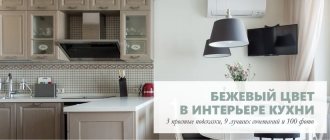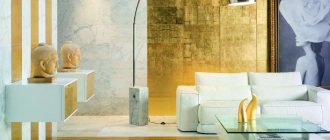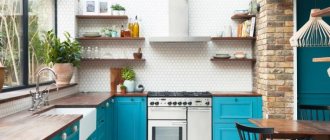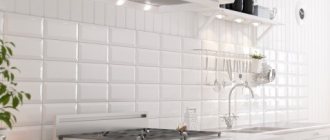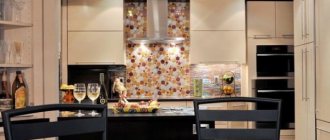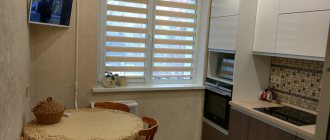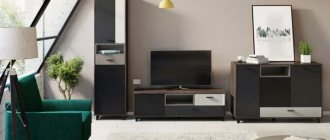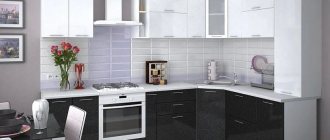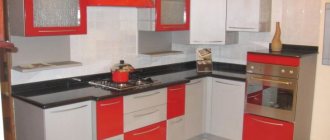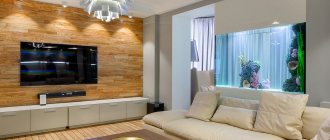/Design/Kitchen color/
A blue kitchen is the best solution for those who live in a hot, sunny country. After all, the main property of the blue color is its ability to create an atmosphere of peace, while “cooling” and refreshing the interior. But is it appropriate in cold Russia, where the kitchen should be the warmest and most comfortable place in the house? Our answer is yes, it is appropriate if used in the right shades, combinations and proportions. For those who are looking for design ideas for their future or existing blue kitchen, we present a selection of 100 inspiring photos and 5 tips for using blue in the interior.
Peculiarities of perception and use of color
When creating a harmonious interior, it is important to take into account the psychology of color. What emotions does this shade evoke? Psychologists say that it has a beneficial effect on the nervous system, calms, helps to concentrate, which is why it is ideal for easily excitable and emotional people. And this is not surprising, because this color was created by nature itself.
However, there is also a downside: in large quantities it can depress, cause associations with a hospital ward, and drive depression and apathy. To avoid a negative effect and find a middle ground, it is important to dilute it with other shades that will balance its severity.
Straight corner set with blue facades in combination with wood-effect facades Corner kitchen set with sky-colored facades
Let's tell you a few facts that will help you better understand how suitable this shade is for decorating your kitchen.
- Blue reduces appetite. On a psychological level, color is associated with peace and serenity and encourages slow and mindful eating.
- Blue is ideal for designing well-lit kitchens with south-facing windows. The bright daytime sun can be tiring, but turquoise or cornflower blue curtains, for example, will just refresh the interior and bring visual coolness.
Kitchen island and bar counter "2 in 1". Bar stools with soft upholstery are like a bright accent.
- Blue is a cool shade. In large quantities it can be depressing and depressing. Therefore, it is important to add warmth to it with the help of other warm tones - cream, milk, butter, etc., as well as with the help of certain materials and textures - surfaces like natural wood or stone, textured plaster finishes, textiles made from natural fabrics with coarse weaving (for example, cotton, linen, matting, burlap), wicker furniture.
Island set with accent island module
A dark wood-look countertop while preserving the natural texture will soften strict, cold facades
- Blue has many similar shades - turquoise, mint, azure, blue-gray, cornflower blue, aqua, hyacinth, aquamarine, etc.
All of them also belong to cool shades, but they produce a different impression. For example, turquoise and aqua are more active and rich compared to the calmer gray-green or mint.
Kitchen with peninsula and turquoise walls
Corner mint set L-shaped set of mint color in a small kitchen
A color scheme
Depending on the brightness, this tone can act as a background, a bright accent, or a complementary shade in a contrasting color scheme. All three examples are shown in the photo below.
Pale blue serves as a neutral, calm background against which bright accents will stand out.
Bright colors do not overload the interior, as they are diluted with achromatic white
As a bright accent against the background of an overall neutral color scheme
The combination with gray and blue creates a monochrome interior. To prevent it from seeming boring, play with the degree of brightness and saturation of shades.
There are several general secrets, knowledge of which will help you easily select successful combinations.
- Pale blue can also be combined with pastel, light shades of other colors.
- Bright blue will go better with equally bright tones. In order not to overdo it in brightness, the interior can be diluted with a neutral white, beige, creamy, creamy or milky shade.
- Blue is the color of the sky and water surface, which means it gets along well with other colors that naturally occur in nature - yellow, blue, brown, beige, sand, green, white, etc.
- If you are not sure which companion shade to choose, choose white. Pale and medium blue paired with white form a calm background, and you can experiment with colored accents and add warm shades using oversized furnishings - kitchen chairs, textiles, decor, etc.
With white
The most win-win combination is with achromatic white. It will help balance the excess of blue in the interior and dilute the bright turquoise or azure shade. White will always save you when you are in doubt about choosing the right compatible tone.
Selection of furniture
The basic principle of harmony is this: the colors on the walls and furniture cannot match. They must belong to different scales. For example, if the walls are blue, then the set, table and chairs are selected in a different color, for example, golden, honey, light green. This will avoid pressure and excess of one shade. If the furniture is made in a blue finish, then the walls should be painted in a different color, such as beige, yellow or light gray.
A kitchen apron is always a slightly different story. Its color is selected to match the set so that it does not blend in with the furniture. However, muted tones are used: grayish or dirty. The wall should not steal all the attention. A bright or very light apron is impractical: all drops, splashes, and dirt will be visible on it.
The finish looks interesting if different colors are combined on it. However, you need to remember their compatibility. And select additional tones so that they match the main one.
The table is the heart of the kitchen. It attracts attention as soon as a person enters the room. A table with a white top will look ideal in a blue kitchen. This solution will refresh the interior and make it lighter. Another win-win option is a wooden countertop.
What style is suitable for a blue kitchen?
This tone is universal and suitable for any design direction. However, in some styles it looks most harmonious.
Modern classic
Blue is an ally of elegance, and therefore neoclassicism. You can dilute it with gray, white, milky, black.
Mediterranean
The name of the style itself already conveys its basic color scheme - shades of blue, blue, sea wave, turquoise, azure. The background is white, light gray, and the accents are yellow, orange and red.
Provence and country
This color will fit especially organically into a rustic-style interior. The natural shade of the sky will harmonize perfectly with the worn and aged surfaces of the Provençal kitchen, with textiles made from coarse fabrics, with solid wood furniture and natural materials with a pronounced texture and texture.
Minimalism
Blue can dilute an ascetic minimalist interior, since this color best suits the mood of the style. It will not be difficult to fit it organically into the overall color scheme, since it goes well with the colors characteristic of minimalism - white, gray, black.
Styles
The range under consideration is more or less compatible with all current trends:
- Rustic. A blue kitchen in country and especially Provence styles is ideal in the space of country houses. Creates a special mood in city housing. The main thing to remember is simplicity and restraint.
- Mediterranean. Associated with freshness and lightness. These properties of the palette in question were discussed above.
- Scandinavian. Blue and white together create the very naturalness that forms the basis of the style.
- Modern, high-tech, minimalism. Today's trends welcome non-standard solutions. The coldness of blue corresponds to the desire for minimalist design.
- Classic and shabby chic. Variegation is not typical, but light shades fit well.
In all cases, we are talking primarily about furniture, textiles, and decorative elements. Walls, ceilings or floors should be decorated in a similar color scheme very carefully so as not to oversaturate the room.
Selection of headset and equipment
How to use blue in the design of facades, which countertop will look best with a blue set, when is matte better, and when is gloss? It is important to think through all these questions together, using our recommendations below.
Facade design
Blue can be used in the design of kitchen facades, combined with other colors, for example, with white, gray, black, yellow or beige, dusty pink or cappuccino color.
Modular kitchen "Fance" Leroy Merlin with mint-colored lower facades
Leroy Merlin kitchen set with paneled facades from the “Tomari” series. Ideal for Provence style design
Richly colored facades can stand out against a neutral background, such as beige, cream, pale yellow or white walls.
When is gloss best?
The more complex and interesting the shade, the heavier the balance will be in favor of matte facades. The matte surface conveys deep tones better and cleaner.
When choosing between matte and glossy, you should also keep in mind ease of maintenance, interior style, and room size. It is easier to remove dirt from a glossy surface, and finger stains will be equally visible on both matte and glossy doors.
The style of the kitchen is much more important. For Provence, neoclassical, scandi and country styles, they often purchase sets with paneled facades, which are not glossy. Gloss is inappropriate in these styles, since their main motto is naturalness.
Light glossy facades will be a good solution in the design of a modern small kitchen. Thanks to the reflective surface combined with an airy, heavenly shade, they will visually expand the space.
Tabletop
The most beautiful option for a kitchen countertop in blue tones - under light or dark wood, preserving the natural texture and natural shade.
Technique
Against the background of blue facades, built-in white, gray, black and metallic appliances will look beautiful.
In retro-style interiors, bright red and orange vintage refrigerators and freestanding stoves with an oven look interesting.
You can go the opposite way and decorate the appliances, rather than the facades, in this color. The retro refrigerator and stoves in a delicate shade of the sky look very original in the interior.
What colors go with blue
A blue kitchen in the interior looks different not only because of the main shade, but also due to additional ones. Next, we’ll find out what to combine blue with to get the perfect picture.
Beige
Kitchens in blue tones can look too cold, especially if the windows face west or north. To avoid a lethargic mood in the design, dilute the base with a warm neutral shade.
Despite the difference, beige goes well with pale blue, neutralizing its negative characteristics.
The photo shows beige shades in furniture and appliances
White
The combination of blue and white is the most classic possible. It is quite contrasting and fresh, so it will be an excellent option for a blue-colored southern kitchen. There will be a lot of light in the room, but at the same time the desired coolness will remain.
Brown
Brown can also complement and “warm up” the blue palette, especially if it is wooden furniture and flooring.
Black
A blue and white kitchen with black accents is a bold and unconventional solution, especially popular in Scandinavian-style interior design.
Black and blue colors in the interior of a kitchen in Provence style
Grey
To prevent the gray-blue kitchen from seeming too cold and gloomy, complement the interior with warm shades, an abundance of white and wooden furniture.
The ash-gray combination looks strict and restrained; the contrast of the combination is much lower than that of the symbiosis with white. To make gray-blue kitchens look harmonious, follow the rule: the lighter the blue, the darker the gray should be.
Red
This contrasting color combination is not often used in kitchen design, but it can be quite harmonious, especially if it is pink-red or orange-red.
Pink
Pink paired with blue can create a different mood depending on the shade. If you use bright pink paints, the kitchen design will become more dynamic and emotional; if you use a soft pink shade, then it will be restrained and too calm.
Therefore, you can use the following combinations: hot pink + baby blue, baby pink + turquoise, baby pink + baby blue + yellow or orange (invigorating colors), baby blue + hot pink + beige (balancing color) etc.
Several examples of such combinations are in the following photo slider.
Yellow
It is believed that yellow is the opposite color to blue and cyan, which means it is complementary and especially suitable for it. In fact, the opposite of blue is orange, but yellow goes well with blue just as well.
The cheerfulness and warmth of yellow more than compensates for the coldness and poise of our hero, so this pair is appropriate in any kitchen - be it northern or southern, but if you want to simulate a calm atmosphere in the kitchen, then use yellow in muted, pale, delicate colors, or in small quantity.
Blue
The blue color is obtained from blue, which has been diluted with white paint. In proximity to blue, blue becomes softer, a play of colors is created, and the effect of freshness and coolness is enhanced, so it is better to avoid such a combination in the design of a “northern” kitchen.
A monochrome kitchen in blue tones is not suitable for everyone: an abundance of blue can have too much of an impact on the nervous system and cause apathy. But if you are constantly stressed and need maximum relaxation at home, then this combination will work to your advantage.
Green
Blue and green are close neighbors in the spectrum, so they harmonize perfectly with each other. Since in nature this union of colors is most often represented by plants (these are cornflowers and bells in the grass, hyacinths with their delicate stems, algae in sea water, tree crowns against the background of the same sky), natural plant shades will be most successful when paired with blue .
Light wood
The most used kitchen design in beige and blue tones is to use light wood surfaces. Bleached oak, ash, and pine look gorgeous in interiors from classic to loft.
What to do with blue color in the kitchen interior?
This color can be used on a large scale only if its brightness is low. Pale blue can be used to decorate walls, floors and ceilings. Bright is suitable for placing accents and as a complementary contrasting color. In the last two cases, the percentage of its content in the interior should not be more than 30. Let's look at specific examples of how the interior will look in each of the listed cases.
Walls and floor
If blue is used to create a background, then for wall decoration you can choose pale blue washable wallpaper or paint. Rich shades can be used to decorate one wall. which will be the main bright spot in the interior.
Pale blue ceramic tiles with a pattern will look beautiful on the floor.
Apron
An apron can act as a background or a bright accent. If you need to somehow dissolve the apron against the general background of the kitchen, then choose tiles or skins of a pale blue, gray-blue hue.
For an accent and bright apron, rich shades of turquoise, azure, and sea green are suitable. Please note that a bright apron should not compete with equally rich facades. One thing has to stand out.
You can support an apron in a sky or turquoise color with other, oversized furnishings, for example, kitchen chairs, curtains, or a tablecloth of the same shade.
If the walls in the kitchen are painted a beautiful cornflower blue shade, then in the apron area you can maintain this tone by ordering transparent frosted glass to protect the work area. This way the design looks cohesive. The idea is especially suitable for decorating a wall free of upper cabinets.
Curtains and textiles
With the help of textile decoration, you can refresh the kitchen, add lightness and airiness to it. In a kitchen with south-facing windows, blue curtains would be an excellent option.
Possible combinations
Blue color is used as a base or auxiliary color. In the first case, pastel shades are preferred, in the second, bright shades are also possible.
A monochrome kitchen can be too relaxing and immerse you in apathy, although for those who are under constant stress due to external factors, it can become a saving refuge.
Cool blues work well with warm neutral tones. There are traditional combinations that work flawlessly.
The blue and white kitchen is a classic, and it’s hard to make a mistake. The space will seem freer and brighter, and the visual coolness created will weaken the degree of perception of incoming sunlight, especially in summer from the south.
A gray-blue kitchen is suitable for lovers of strict restraint. The contrast here is weaker than in the previous combination. It is important to follow the inverse relationship rule: the more contrasting one of these colors is, the lighter the other should be.
Blue combined with brown is impressive and at the same time cozy. Considering that the kitchen set is often made of wood, it is enough to add azure in the details to achieve harmony in the decoration.
Bright colors are also welcome. Primarily rich yellow or orange. Green in similar shades (for example, mint) works well, however, like blue, it works for relaxation. There is no need to be afraid of active red, as long as you remember to use a sense of proportion.
Decor options
If the overall design of the kitchen is made in blue tones, then bright elements of orange, yellow, red, green, and blue can be used as decor. This could be a tablecloth, flowerpot, painting, vase, chair cushions or napkins for cutlery.
Decorative elements of a blue hue will also help to dilute the monochrome interior, introducing color variety into it.
An interior that is too bright, for example, with a predominance of yellow, can be balanced by blue, bringing calm and rigor.
House plants can be the finishing touch to the design. Green leaves will harmonize with the overall color scheme and enliven the atmosphere.
Tips from designers
If your kitchen is made up of blues and grays, it can be transformed with invigorating bright shades. For example, red, yellow, pink are perfect for changing the kitchen.
Blue color can be slightly diluted with warm colors, such as beige or cream, or another option with brown and soft yellow colors. It is best to use a dining set made of wood and matte tones.
For a small kitchen it is better to use a light blue shade; it will increase the space. In addition, you can often change furniture or curtains, because any decision or change always suits these shades.
If it is difficult to decide which color scheme to choose, then you should pay attention to color schemes that have already been tested and are ready for implementation. It’s not at all difficult to draw up a diagram yourself; you just have to turn to nature.
All companion colors look perfect, because they are related shades. But in a neutral palette it is better to use light colors. Combinations of bright colors are perfect for contrasting colors.
Note!
- Turquoise kitchen: TOP-150 photos of fashionable turquoise kitchen design ideas + reviews of stylish interiors
Light green kitchen - TOP 130 photo reviews of light green kitchen design and decor. Features of the style of furniture and decor in the interior
Lilac kitchen - features of lilac shades in the interior. Stylish kitchen design ideas with photo examples
Features of blue kitchen lighting
With improperly organized lighting, a kitchen in blue tones in the evening risks turning into gloomy and uncomfortable. Cool shades need good artificial lighting more than others. To do this, it is important to provide not only central lighting, but also illumination of the work area and local lighting of the dining area.
For artificial lighting, choose warm light.
